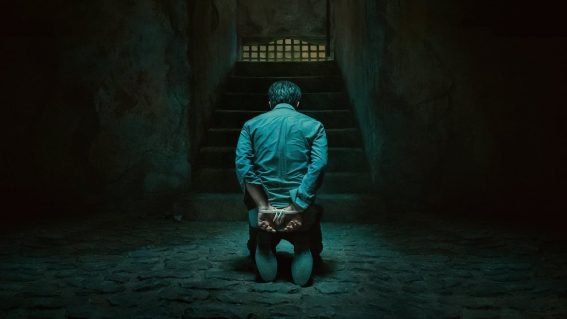Why Money Heist is a hugely addictive Netflix crime show

The explosive crime drama Money Heist is Netflix’s most popular foreign show. Critic Luke Buckmaster decided to investigate what all the fuss was about—and became totally hooked.
The Netflix homepage algorithm can be a persistent bugger of a thing. It serves us the same titles again and again, with the consistency of a beating heart in an Edgar Allan Poe story, until we eventually either press play or check ourselves into the local sanatorium. Its localised ‘Top 10 Today’ homepage widget is persistent too, in a more passive aggressive manner. You see a title there once, you ignore it. If it doesn’t go away for a few days you can’t help but think: am I missing out on something?
See also
* All new movies & series on Netflix
* All new streaming movies & series
That is how I came to watch the pulse-pounding Spanish crime thriller Money Heist: it was simply there. Staring back at me from that widget for days on end.
Álex Pina’s hit series (its original Spanish title is La casa de papel) certainly does what it says on the tin. It is very much about a money heist. The central location in fact is the Royal Mint of Spain, a place where cold hard cash is not just stored but printed, the production aspect affording the robbers more possibilities than your standard garden variety sting. The gang refer to each other using the aliases of international cities—among them protagonist Tokyo (Úrsula Corberó), jewel thief Berlin (Pedro Alonso) and forgery expert Nairobi (Alba Flores)—and wear plastics masks of Salvador Dali.
Very soon I was hooked
Halfway through the first episode they have already arrived, masked up, with hostages against the wall and a police negotiator (Itziar Ituño) on the horn. I assumed that season one would include multiple heists—given it is 13 episodes long, and hinging an entire season on one job in a single location seemed unlikely.
But no. One heist. And for me, one big initial viewing session. Beaten down by that homepage widget, I hit play and emerged five episodes later, as if from a trance, totally hooked. During the next session I smashed through five more.
The narrative is stretched out but the pace isn’t slow—in fact it’s hellaciously fast. I don’t mean fast like a Michael Bay production, with sparks of frantically edited visuals flying every which-way, confusing viewers as to who is doing what to whom. Pina and his directors and screenwriters show great flair for narrative economy, keeping the series moving on all levels: visually, narratively, thematically. The writing is compact and muscular. It has the problem solving flavour of a Vince Gilligan writers room approach, giving the question of what happens next as much priority as any drama in the current moment.
The show has two big tricks up its sleeves
When it comes to hooking an entire season on a single heist, the filmmakers have two key tricks up their sleeve. The first is a nonlinear timeline containing semi-frequent flashbacks, and the second Tokyo’s extensive grab-you-by-the-throat voice-over narration. A dangerous and volatile young woman on the lam, she is the kind of person you might call a dark horse or a wild card; someone who is reliably unpredictable.
Like the trajectory of protagonists in Luc Besson’s hardboiled female assassin films, such as La Femme Nikita and Anna, Tokyo experiences a grim kind of rebirth. Her extreme criminal exploits give her life new meaning, at the not-insignificant cost of being damned forever.
She is also a compelling example of the ‘unreliable narrator’, a concept often related to characters who are lying, mentally unwell, or do not treat their narrator duties seriously, like somebody goofing around on their day job. Tokyo’s narration is a kind of Dear Diary on steroids, candid in an almost stream of consciousness style, loaded with all sorts of grudges and biases and preconceptions, her character caring not one iota about providing a balanced perspective or an impartial view of things.
The pace is wickedly fast
Tokyo’s explosive turns of phrase create an almost literary kind of commentary, its energy matched and even eclipsed by the show’s turbo-charged visual style. From go to whoa Money Heist has a very mean whoosh to it. Episode one begins with a blood red-tinted shot of Tokyo in bed, then jumps from an extreme close-up of her eyeball to a shot that uses focus pulling and forward movement simultaneously, switching emphasis from the barrel of a gun to Úrsula Corberó’s intense face. She delivers a magnetic and compulsively watchable performance, keeping the show thrilling on a human level.

In the first five minutes Money Heist has covered off on Tokyo’s backstory, including the loss of a loved one (“the last time I saw him I left him in a pool of blood…mixing love and business never works”), the severing of ties between her and her family (mum snitched to the police) and her recruitment by heist mastermind The Professor (Álvaro Morte, who is a fun presence but too young for the role). He is adamant that they will pull off the “perfect” heist (at least, in theory: you know how these things roll).
So the show is fast. Very fast. This kind of lickety-split approach requires a lot of discipline.
When film and TV creators speak to media outlets about their work, they are often more than a little prone to self-flattering and hyperbole. I am inclined to agree however with the words Álex Pina used to describe the show to The Guardian. “It is a brutal journey to the limit, like a ride on a vertiginous roller coaster,” he said. “I can promise the audience will not think of Covid-19 while watching it.”

















